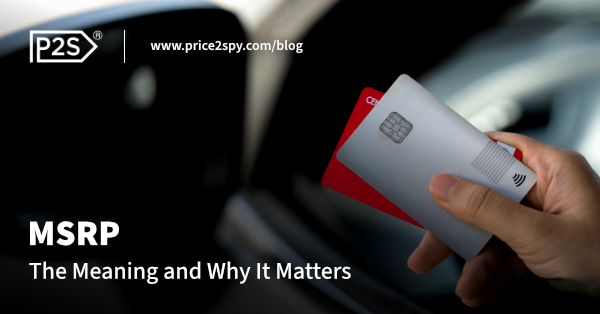
MSRP Meaning: What It Is and Why It Matters
MSRP, or Manufacturer’s Suggested Retail Price, is a familiar term in retail, but it’s often misunderstood. It may seem like the official price, but in reality, it’s only a recommendation from the manufacturer to the retailer.

Knowing how MSRP works, how it differs from MAP, and what happens when it’s discounted helps make sense of how products are priced today.
MSRP meaning and key points
MSRP is the price a manufacturer recommends for their products to be sold at.
It’s not legally binding but serves as a reference point for retailers and customers.
People frequently use following terms synonymously with MSRP:
- List price;
- Sticker price.
If there’s anything you should remember about MSRP it’s this:
- MSRP is set by the manufacturer, not the retailer.
- Its main purpose is to standardize pricing across different sellers, and thus control brand perception.
- Most frequently seen with consumer goods such as electronics, cars, and appliances.
- Retailers can sell above or below MSRP. This depends on their pricing strategy, levels of demand, or promotions.
MSRP and discounts
Technically speaking, there’s no violation of MSRP. It is a suggestion to the seller, not an obligation. There’s no legal requirement for sellers to abide by MSRP.
Retailers often sell below MSRP during promotions. Occasional discounts are fine, but frequent undercutting can erode brand value and train customers to never pay full price.
Breaking from MSRP during the discount season isn’t inherently bad. Diverting away from it can be okay, if it’s a part of a broader pricing strategy. However, one major risk should always be kept in mind: consistently violating MSRP leads to brand devaluation.
When a product is consistently sold at 20%, 30%, or even 50% off its “suggested” price, customers begin to see that lower price as the real value. This trains consumers to wait for sales and discounts, and affects their purchase decision.
MSRP vs MAP – what’s the difference?
While MSRP is a suggestion, MAP (Minimum Advertised Price) is a contractual limit on how low a product can be advertised. Violating MAP can lead to penalties from the manufacturer.
MAP restricts how low a product can be advertised, not sold. Violating MAP can lead to consequences like losing supplier support or access to promotional funding.
MSRP isn’t mandatory, but it shapes how products are priced, perceived, and promoted in the market.
Regional Pricing Differences
MSRP is not always a fixed global number. It often differs from country to country or even between regions within the same country.
These variations reflect differences in local taxes, import duties, shipping costs, and overall market conditions. A product that costs $100 in the U.S. might have an MSRP of €120 in Europe or ¥13,000 in Japan.
Beyond logistics and tax structures, consumer purchasing power plays a role in regional MSRP adjustments.
Manufacturers may price products lower in emerging markets to remain competitive, even if the product is identical. Conversely, premium pricing in high-income regions can help maintain a brand’s upscale positioning.
Retailers and distributors must be careful when referencing MSRP in international marketing or cross-border selling.
A listed MSRP may not be relevant or accurate for all audiences, leading to confusion or regulatory issues. This is especially important in ecommerce, where global visibility blurs national price boundaries.
Industries where MSRP matters most
While MSRP can apply across many retail categories, it is especially prevalent in certain industries where price consistency and perceived value are important.
These include sectors like automotive, electronics, apparel, and home appliances. In these cases, MSRP serves as a clear pricing anchor for both retailers and consumers.
In the automotive industry, MSRP is famously displayed as the “sticker price” on car windows at dealerships. It provides a reference point for negotiations, even though customers often expect to pay less. Car manufacturers rely on MSRP to communicate uniform pricing across different regions and dealers.
In consumer electronics and fashion, MSRP is used to signal a product’s original value before any markdowns or promotions. Retailers may display the MSRP alongside a sale price to highlight perceived savings. This practice reinforces the product’s premium positioning, even during discount-heavy seasons.
Conclusion
MSRP is more than just a suggested number. It helps shape customer expectations, supports consistent pricing, and signals a product’s value.
While not legally binding, it can still influence retail behavior and brand perception, especially when paired with MAP agreements. MSRP can vary by region, play different roles across industries, and lose impact if frequently discounted.
Used wisely, it supports both sales strategy and brand integrity.



